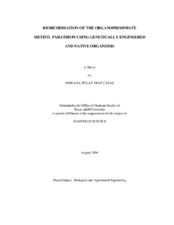| dc.contributor.advisor | Engler, Cady | |
| dc.creator | Diaz Casas, Adriana Z. | |
| dc.date.accessioned | 2005-11-01T15:49:19Z | |
| dc.date.available | 2005-11-01T15:49:19Z | |
| dc.date.created | 2004-08 | |
| dc.date.issued | 2005-11-01 | |
| dc.identifier.uri | https://hdl.handle.net/1969.1/2684 | |
| dc.description.abstract | Toxic waste disposal problems have become enormous due to the proliferation of xenobiotic compounds for use in agricultural, industrial and numerous other applications. Organophosphate (OP) pesticides are commonly used in agriculture and their toxicity is associated with inhibition of cholinesterase in the exposed organism. Some OPs have been shown to produce OP-induced delayed neuropathy (OPIDN). The overall goal of the work described in this thesis was to develop bacterial consortia to remediate hazardous substances at significantly higher rates than found with natural systems. Specifically, degradation of methyl parathion (MP) by hydrolysis with a genetically engineered Escherichia coli was investigated along with degradation of one of the resulting products, p-nitrophenol (PNP), by Sphingobium chlorophenolicum ATCC 53874. Simultaneous degradation of both MP and PNP was investigated using a consortium of a genetically engineered Escherichia coli and a native
S. chlorophenolicum. Concentrations of MP and PNP were measured by high performance liquid chromatography (HPLC). Non-growing freely suspended recombinant OPH+ E. coli cells efficiently degraded MP without addition of nutrients for growth. Maximum reactor productivity was found with a biomass concentration of 25 g/L. Substrate inhibition did not occur up to 3 g MP/L. The simple Michaelis-Menten kinetic model for enzymatic reactions provided a good fit of the degradation data with Vm=11.45 ??mol/min??g-biomass and Km=2.73 g/L. B. cepacia failed to degrade PNP under the experimental conditions evaluated, so further studies were not conducted. Growing cultures of S. chlorophenolicum degraded PNP at concentrations up to 0.1 g/L without a lag phase in mineral salts glutamate medium. Parameters such as initial pH, growth medium and growth stage for addition of PNP were important degradation factors. The bacterium exhibited substantial growth in the degradation process. Hydroquinone (HQ) or nitrocatechol (NC) were not identified as products of PNP degradation. The recombinant OPH+ E. coli and S. chlorophenolicum consortium failed to degrade PNP when starting with higher concentrations of MP. The presence of organic solvent in the bacterial consortium degradation medium negatively affected the degradation of PNP. The genetically engineered organism efficiently degraded high concentrations of MP, but the resulting high concentration of intermediate product (PNP) inhibited growth of the native type organism. Biodegradation by consortia of genetically engineered non-growing and native-type organisms generally will be limited by the growing native-type organism. | en |
| dc.format.extent | 579734 bytes | en |
| dc.format.medium | electronic | en |
| dc.format.mimetype | application/pdf | |
| dc.language.iso | en_US | |
| dc.publisher | Texas A&M University | |
| dc.subject | Methyl parathion | en |
| dc.subject | p-Nitrophenol | en |
| dc.subject | E. coli | en |
| dc.subject | Sphingobium chlorophenolicum | en |
| dc.subject | bioremediation | en |
| dc.subject | biodegradation | en |
| dc.title | Bioremediation of the organophosphate methyl parathion using genetically engineered and native organisms | en |
| dc.type | Book | en |
| dc.type | Thesis | en |
| thesis.degree.department | Biological and Agricultural Engineering | en |
| thesis.degree.discipline | Biological and Agricutural Engineering | en |
| thesis.degree.grantor | Texas A&M University | en |
| thesis.degree.name | Master of Science | en |
| thesis.degree.level | Masters | en |
| dc.contributor.committeeMember | Kenimer, Ann | |
| dc.contributor.committeeMember | Wild, James | |
| dc.type.genre | Electronic Thesis | en |
| dc.type.material | text | en |
| dc.format.digitalOrigin | born digital | en |


